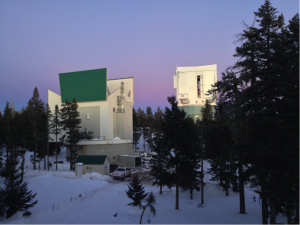
Sunset at MGIO as seen from the VATT. The Heinrich Hertz Submillimeter Telescope is on the left, and the Large Binocular Telescope on right.
We, Min Fang and Ben Rackham, are on a five-night observing run at the Vatican Advanced Technology Telescope (VATT), where we are collecting spectra of young stars. This post gives some of the highlights of our trip so far.
The VATT is located in southeastern Arizona at the Mount Graham International Observatory (MGIO) near Mount Graham, the highest peak of the Pinaleño Mountains. The Pinaleños are one of the largest of the “Sky Islands,” a series of tall mountain ranges in southeastern Arizona and northern Mexico surrounded by a sea of desert. At 10,720 ft, Mount Graham is the highest peak in southern Arizona, towering more than 7,500 ft above the surrounding desert. The huge relief of the Pinaleños combined with the clear skies of southern Arizona makes MGIO a great site for astronomy. It also means Mount Graham is very isolated from similar ecosystems, making species that rely on the spruce-fir habitat only found near the summit very vulnerable to habitat disruption. Accordingly, the entire footprint of MGIO is only 8.6 acres. Within that footprint, MGIO hosts the VATT, the Heinrich Hertz Submillimeter Telescope, and the Large Binocular Telescope. The LBT, with its two 8.4-meter-diameter mirrors, is one of the largest and most advanced optical telescopes in the world.
We left Tucson for the VATT just after noon on Thursday. The VATT’s only 70 miles northeast of Tucson as the crow flies, but the trip takes 3 ½ hours. About half of that time is spent getting to the base of the mountain, where you stop at base camp to sign in, pick up radios and gate keys, and pet the unnamed stray cat that welcomes visitors, and the other half is spent driving up the curvy Swift Trail Parkway as it winds its way to the summit. After the long drive up the mountain and the precipitous, four-wheel-drive climb up the final two miles, we were greeted at the VATT with a snowpack four feet deep and temperatures a full 40 degrees cooler than those we left in Tucson.

The 1.8-meter primary of the VATT. It looks cool and green because we were testing out the green LED for calibration purposes.
We arrived a day early so that Peter Milne could show us how to use the spectrograph on the last night of his run. Being a relatively small telescope (the diameter of the primary mirror is 1.8 meters, which places it on the small end of today’s professional telescopes), the VATT forgoes many of the bells and whistles you find at larger telescopes today. Need to change the grating in the spectrograph? Better grab an Allen wrench. These little touches just add to the experience. Peter showed us the nuts and bolts of the spectrograph (figuratively and literally) on Thursday night while we helped with his program of classifying recent supernovae.
We’re using VATTSpec to gather optical spectra of a sample of young stars very interesting to the EOS Project. Young stars are expected to disperse their circumstellar disks a few million years after their formation. However, members of the EOS team recently found a sample of ~100 candidate pre-main sequence (PMS) stars in the Perseus OB2 association (12 million years old) that are relatively bright in the infrared, an excess that usually indicates a warm circumstellar disk. Could these 12-million-year old PMS stars really still have circumstellar disks? If so, why would disk-bearing PMS stars still be abundant in this association? Are these disks still gas-rich at such an old age? All these questions warrant a detailed investigation of this sample. We are using VATTSpec to obtain optical spectra of these sources spanning 6000–8000 Å. We aim to confirm their youth using the lithium absorption line (6707 Å), characterize their accretion activities using the H-alpha line (6563 Å), and obtain their spectral types using the complete spectrum. With the spectral types, in combination of their broad-band photometry, we can derive their stellar properties (mass and ages) by placing them in the HR diagram. These “old” disk systems will provide a great opportunity to understand the mechanism of disk dispersal and hunt for young planets that are still embedded in disks.
At least, that’s the plan, provided the weather and telescope cooperate. Unfortunately, the weather didn’t cooperate for the first two nights of our run. It was either too cloudy, too humid to open the dome (we don’t want water condensing / ice freezing on the mirror or telescope electronics), or both. Tonight, the third night of our run, the weather is great and, after troubleshooting a connection problem with the guider camera (turns out it was unplugged), we finally got on the sky. We are collecting a lot of good-quality spectra of these interesting young stars, and hoping the good weather holds through tomorrow night, the last one of our run.
Stay tuned to publications from Min Fang and the EOS team to learn more about “old” young stars with disks!


